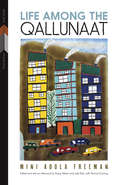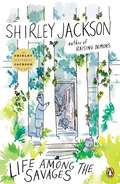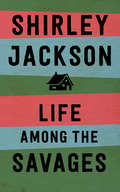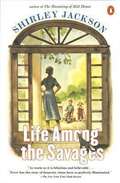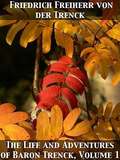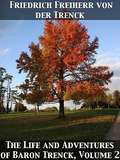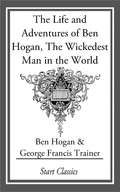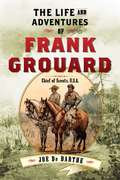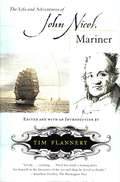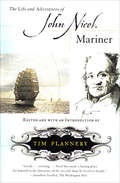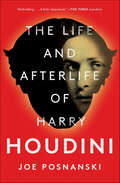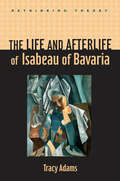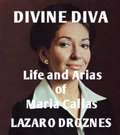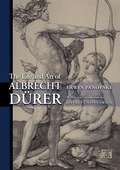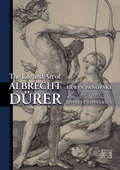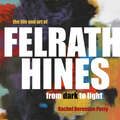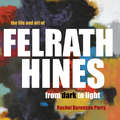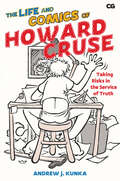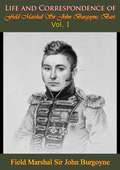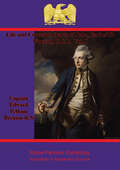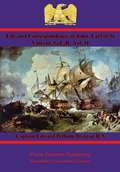- Table View
- List View
A Life Almost Wasted
by David WardA story of a successful chiropractor as a young man debating if his life was worth living. He found God while climbing a tower. God guided his life and was a good partner.
Life Among the Dead
by Lisa WilliamsThe highly anticipated memoir from the star of the hit series Lisa Williams: Life Among the Dead When Lisa Williams was four years old, she told her parents about the spirits in her bedroom. Since those first sightings, Lisa has seen and communicated with thousands of people who have passed over, listening to their stories and delivering messages of comfort to the loved ones they left behind. In Life Among the Dead, Lisa invites readers into her extraordinary life, from her childhood in Birmingham, England, where her grandmother -- also a renowned psychic -- encouraged her to respect and nurture her talent, to her decision to move to Los Angeles, where her smash-hit Lifetime television show quickly made her one of the world's most beloved mediums. Lisa shares memories of her earliest psychic experiences and her gradual acceptance of her gift, and recalls many of the amazingly accurate communications she has shared with believers and skeptics alike. In her compassionate, down-to-earth style, she reveals exactly what it's like to live surrounded by spirits every day, and she recounts the joy she feels in bringing solace to those who have lost someone dear and the insights she has gleaned about spiritual phenomena, hauntings, psychic healing, and the afterlife. Warm, witty, and surprising, Life Among the Dead is a wonderfully intimate account of Lisa's life as a medium, healer, wife, mom, and TV star who has already won the hearts of millions, a woman with an astonishing gift for seeing beyond the ordinary and into a mysterious and fascinating realm.
Life Among the Qallunaat (First Voices, First Texts #3)
by Julie Rak Mini Aodla Freeman Keavy Martin Norma DunningLife Among the Qallunaat is the story of Mini Aodla Freeman’s experiences growing up in the Inuit communities of James Bay and her journey in the 1950s from her home to the strange land and stranger customs of the Qallunaat, those living south of the Arctic. Her extraordinary story, sometimes humourous and sometimes heartbreaking, illustrates an Inuit woman’s movement between worlds and ways of understanding. It also provides a clear-eyed record of the changes that swept through Inuit communities in the 1940s and 1950s. Mini Aodla Freeman was born in 1936 on Cape Hope Island in James Bay. At the age of sixteen, she began nurse's training at Ste. Therese School in Fort George, Quebec, and in 1957 she moved to Ottawa to work as a translator for the then Department of Northern Affairs and Natural Resources. Her memoir, Life Among the Qallunaat, was published in 1978 and has been translated into French, German, and Greenlandic. Life Among the Qallunaat is the third book in the First Voices, First Texts series, which publishes lost or under appreciated texts by Indigenous writers. This reissue of Mini Aodla Freeman’s path-breaking work includes new material, an interview with the author, and an afterword by Keavy Martin and Julie Rak, with Norma Dunning.
Life Among the Savages
by Shirley JacksonIn a hilariously charming domestic memoir, America's celebrated master of terror turns to a different kind of fright: raising childrenIn her celebrated fiction, Shirley Jackson explored the darkness lurking beneath the surface of small-town America. But in Life Among the Savages, she takes on the lighter side of small-town life. In this witty and warm memoir of her family's life in rural Vermont, she delightfully exposes a domestic side in cheerful contrast to her quietly terrifying fiction. With a novelist's gift for character, an unfailing maternal instinct, and her signature humor, Jackson turns everyday family experiences into brilliant adventures.
Life Among the Savages
by Shirley JacksonShirley Jackson, author of the classic short story "The Lottery", was known for her terse, haunting prose. But the writer possessed another side, one which is delightfully exposed in this hilariously charming memoir of her family's life in rural Vermont. Fans of Please Don't Eat the Daisies, Cheaper by the Dozen, and anything Erma Bombeck ever wrote will find much to recognize in Shirley Jackson's home and neighborhood: children who won't behave, cars that won't start, furnaces that break down, a pugnacious corner bully, household help that never stays, and a patient, capable husband who remains lovingly oblivious to the many thousands of things mothers and wives accomplish every single day. "Our house", writes Jackson, "is old, noisy, and full. When we moved into it we had two children and about five thousand books; I expect that when we finally overflow and move out again we will have perhaps twenty children and easily half a million books". Jackson's literary talents are in evidence everywhere, as is her trenchant, unsentimental wit. Yet there is no mistaking the happiness and love in these pages, which are crowded with the raucous voices of an extraordinary family living a wonderfully ordinary life.
Life Among the Savages
by Shirley JacksonIn a hilariously charming domestic memoir, America’s celebrated master of terror turns to a different kind of fright: raising children. In her celebrated fiction, Shirley Jackson explored the darkness lurking beneath the surface of small-town America. But in Life Among the Savages, she takes on the lighter side of small-town life. In this witty and warm memoir of her family’s life in rural Vermont, she delightfully exposes a domestic side in cheerful contrast to her quietly terrifying fiction. With a novelist’s gift for character, an unfailing maternal instinct, and her signature humor, Jackson turns everyday family experiences into brilliant adventures.
Life among the Savages
by Shirley JacksonShirley Jackson, author of the classic short story The Lottery, was known for her terse, haunting prose. But the writer possessed another side, one which is delightfully exposed in this hilariously charming memoir of her family's life in rural Vermont. Fans of Please Don't Eat the Daisies, Cheaper by the Dozen, and anything Erma Bombeck ever wrote will find much to recognize in Shirley Jackson's home and neighborhood: children who won't behave, cars that won't start, furnaces that break down, a pugnacious corner bully, household help that never stays, and a patient, capable husband who remains lovingly oblivious to the many thousands of things mothers and wives accomplish every single day. "Our house," writes Jackson, "is old, noisy, and full. When we moved into it we had two children and about five thousand books; I expect that when we finally overflow and move out again we will have perhaps twenty children and easily half a million books. " Jackson's literary talents are in evidence everywhere, as is her trenchant, unsentimental wit. Yet there is no mistaking the happiness and love in these pages, which are crowded with the raucous voices of an extraordinary family living a wonderfully ordinary life. Continuously in print since 1948, Jackson's Haunting of Hill House has been bought by Dreamworks. .
The Life and Adventures of Baron Trenck, Volume 1
by Freiherr von der Friedrich TrenckThere were two cousins Von der Trenck, who were barons descended from an ancient house in East Prussia, and were adventurous soldiers, to whom, as to the adventurous, there were adventures that lost nothing in the telling, for they were told by the authors' most admiring friends- themselves. Franz, the elder, was born in 1711, the son of an Austrian general; and Frederick, whose adventures are here told, was the son of a Prussian major-general. Franz, at the age of seventeen, fought duels, and cut off the head of a man who refused to lend him money. He stood six feet three inches in his shoes, knocked down his commanding officer, was put under arrest, offered to pay for his release by bringing in three Turks' heads within an hour, was released on that condition, and actually brought in four Turks' heads. When afterwards cashiered, he settled on his estates in Croatia, and drilled a thousand of his tenantry to act as "Pandours" against the banditti. In 1740, he served with his Pandours under Maria Theresa, and behaved himself as one of the more brutal sort of banditti.
The Life and Adventures of Baron Trenck, Volume 2
by Freiherr von der Friedrich TrenckThomas Holcroft, the translator of these Memoirs of Baron Trenck, was the author of about thirty plays, among which one, The Road to Ruin, produced in 1792, has kept its place upon the stage. He was born in December, 1745, the son of a shoemaker who did also a little business in horse-dealing. After early struggles, during which he contrived to learn French, German, and Italian, Holcroft contributed to a newspaper, turned actor, and wrote plays, which appeared between the years 1791 and 1806. He produced also four novels, the first in 1780, the last in 1807. He was three times married, and lost his first wife in 1790. In 1794, his sympathy with ideals of the French revolutionists caused him to be involved with Hardy, Horne Tooke, and Thelwall, in a charge of high treason; but when these were acquitted, Holcroft and eight others were discharged without trial.
The Life and Adventures of Ben Hogan,
by Benedict HoganBenedict Hagan, whose name has become familiar in the altered form of Hogan, is a native of Würtemberg, Germany. With his parents, he immigrated to this country at the age of eleven years. His father was a cabinet-maker by trade, who had saved up something like a thousand dollars, with which he set forth to better his condition in the New World. Along with his family, he arrived in New York in the summer of 1852. His reception was not of the most encouraging nature, and an incident which occurred almost immediately after the landing of the family will serve to show the character of Hogan at that time. As was customary with all emigrants who had any money to carry, the elder Hogan had secured his fortune, amounting to eight hundred dollars in gold, in a belt fastened about his shoulders. When he walked out of Castle Garden he was forthwith set upon by a Hebrew of the South street order, whose nose resembled his nature, because it was sharp. This enterprising Jew, who spoke German fluently, induced the emigrant to go into a small shop where everything was given away--for four times its value. The unsuspecting Hogan made a small purchase, and when he came to pay for it, disclosed the bag containing his gold. The sight was enough to rouse the Hebrew. Precisely how it happened he did not know; but in an amazingly short time Hogan senior found himself relieved of his eight hundred dollars. Had it not been for the presence of young Ben, it may be safely assumed that the emigrant would never have gone forth from the Jew's place alive. The boy, however, presented an obstacle to the commission of murder, which was undoubtedly intended by the robbers. They determined, therefore, to get rid of their victims by strategy instead of force. One of their "cappers" offered to lead the way to the police station where they might get assistance in recovering the money. He did lead the way, but it is unnecessary to add that there were not a great many police stations in the neighborhood to which he conducted them. The Hebrew perhaps thought that he had made one of the fattest "hauls" in his life; but it turned out to be a very dear job.
The Life and Adventures of Frank Grouard: Chief of Scouts, U.S.A.
by Joe De BartheThe true story of the one of the most thrilling figures of the Wild West.Every army needs its scouts. A good scout knows the enemy and the enemy's terrain as well as his own, and is resourceful and incisive, cool-headed and courageous. A great scout is irreplaceable. And no greater scout than Frank Grouard has ever served in the US Army. During the Indian Wars in the American West, he was so valuable that General George Crook, considered the greatest of Indian fighters, said he would rather have lost a third of his command than Frank Grouard.Indeed, few lives rival Grouard's for sheer excitement, danger, and achievement. He claimed to have been born on an island in the South Pacific, the son of a Mormon missionary and his Polynesian wife-although others said he was part Indian. Among his many admirers was the great warrior Chief Sitting Bull, who saved young Grouard from death, gave him the Sioux name Standing Bear, held him semiprisoner, and raised him to be a Sioux warrior. He hunted with the Sioux, learned their language, and became skilled at reading the land for the presence of enemies. But when the chance came to escape, he took it, landing work as a scout for General Crook shortly thereafter.Grouard once carried urgent dispatches over one hundred miles in less than four hours, an incredible feat on horseback, and was instrumental in setting up negotiations for the final surrender after Wounded Knee. After the wars, he laid out the first all-weather mail route over the Big Horn Mountains, which he accomplished on foot in the dead of winter.The Life and Adventures of Frank Grouard is the classic firsthand account-dictated to Joe De Barthe, a young journalist-of one of the greatest men of the era.
The Life and Adventures of John Nicol, Mariner
by Tim FlanneryAn international bestseller, The Life and Adventures of John Nicol, Mariner is a rousing memoir of an ordinary man's extraordinary life, a gripping true adventure tale. In his many voyages, the Scottish-born sailor John Nicol (1755-1825) twice circumnavigated the globe, visiting every inhabited continent while participating in many of the greatest events of exploration and adventure of the eighteenth century. During his career Nicol battled pirates, traded with Native Americans, and fought for the British Navy in the American and French revolutions. In Hawaii, he was entertained by the King's court mere days after the murder of Captain James Cook. In Jamaica, he saw firsthand the horrors of the slave system and befriended slaves who invited him to join in their dance celebrations. En route to Australia, he would meet the love of his life, Sarah Whidam, a convict bound for the Botany Bay prison colony, who would bear his son before duty forced them apart forever.
The Life and Adventures of John Nicol, Mariner
by Tim FlanneryThe Thrilling True Story of an Eighteenth-Century Sailor’s Extraordinary VoyagesThe Life and Adventures of John Nicol, Mariner is a recently rediscovered text that vividly renders the unforgettable story of a man whom history has nearly forgotten.In his many voyages the Scottish-born sailor John Nicol twice circumnavigated the globe, visiting every inhabited continent while witnessing and participating in many of the greatest events of exploration and adventure in the eighteenth century. He traded with Native Americans on the St. Lawrence River and hunted whales in the Arctic Ocean. He fought for the British navy against American privateers in the Atlantic Ocean and Napoléon’s navy in the Mediterranean Sea. In Grenada he witnessed the horrors of the slave system and befriended slaves who invited him to join in their dance celebrations. In the Sandwich Islands (Hawaii) he was entertained by the king’s court mere days after the murder of Captain James Cook. En route to Australia he would meet the love of his life, Sarah Whitlam, a convict bound for the Botany Bay prison colony, who would bear his son before duty forced them apart forever.At the end of his journeys, John Nicol returned to his homeland and a life of obscurity and poverty, until the publisher John Howell met him one day while he was wandering the streets of Edinburgh, searching for dregs of coal to fuel his hearth. After hearing the fascinating stories of Nicol’s seafaring experiences, Howell convinced him to write his memoirs-the publication of which eventually earned Nicol enough money to live comfortably for the rest of his days.An international bestseller, The Life and Adventures of John Nicol, Mariner is a rousing, eminently readable memoir of an ordinary man’s extraordinary life-a great, true-adventure tale. Celebrated scientist and historian Tim Flannery has edited Nicol’s original text, providing accompanying footnotes and an introduction (updated for this North American edition) that give historical context to the sailor’s exploits.
The Life and Afterlife of Harry Houdini
by Joe PosnanskiJoe Posnanski enters the colorful world of Harry Houdini and his legions of devoted fans to explore the illusionist&’s impact on global culture—and why his legacy endures to this day. Nearly a century after Harry Houdini died on Halloween in 1926, he feels as modern and alive as ever. The name Houdini still leaps to mind whenever we witness a daring escape. The baby who frees herself from her crib? Houdini. The dog who vanishes and reappears in the neighbor&’s garden? Houdini. Every generation produces new disciples of the magician, from household names in magic like David Copperfield and David Blaine to countless other followers whose lives have been transformed by the power of Houdini.In rural Pennsylvania, a thirteen-year-old girl finds the courage to leave a violent home after learning that Houdini ran away to join the circus; she eventually becomes the first female magician to saw a man in half on television. In Australia, an eight-year-old boy with a learning impediment feels worthless until he sees an old poster of Houdini advertising &“Nothing on earth can hold Houdini prisoner,&” and begins his path to becoming that nation&’s most popular magician. In California, an actor and Vietnam War veteran finds purpose in his life by uncovering the secrets of his hero.But the unique phenomenon of Houdini was always more than his death-defying stunts or his ability to escape handcuffs and straitjackets. It is also about the power of imagination and self-invention. His incredible transformation from Ehrich Weiss, humble Hungarian immigrant and rabbi&’s son, into the self-named Harry Houdini has won him a slice of immortality. No one has withstood the test of time quite like Houdini. Fueled by Posnanski&’s personal obsession with the magician—and magic itself—The Life and Afterlife of Harry Houdini is a poignant odyssey of discovery, blending biography, memoir, and first-person reporting to trace Houdini&’s metamorphosis into an iconic figure who has inspired millions.
The Life and Afterlife of Isabeau of Bavaria (Rethinking Theory)
by Tracy AdamsThe fascinating history of Isabeau of Bavaria is a tale of two queens. During her lifetime, Isabeau, the long-suffering wife of mad King Charles VI of France, was respected and revered. After her death, she was reviled as an incompetent regent, depraved adulteress, and betrayer of the throne. Asserting that there is no historical support for this posthumous reputation, Tracy Adams returns Isabeau to her rightful place in history. Adulteress and traitor—two charges long leveled against the queen—are the first subjects of Adam’s reinterpretation of medieval French history. Scholars have concluded that the myths of Isabeau’s scandalous past are just that: rumors that evolved after her death in the context of a political power struggle. Unfortunately, this has not prevented the lies from finding their way into respected studies on the period. Adams’s own work serves as a corrective, rehabilitating the reputation of the good queen and exploring the larger topic of memory and the creation of myth. Adams next challenges the general perception that the queen lacked political acumen. With her husband incapacitated by insanity, Isabeau was forced to rule a country ripped apart by feuding, power-hungry factions. Adams argues that Isabeau handled her role astutely in such a contentious environment, preserving the monarchy from the incursions of the king’s powerful male relatives. Taking issue with history’s harsh treatment of a woman who ruled under difficult circumstances, Adams convincingly recasts Isabeau as a respected and competent queen.
Life and Arias of María Callas
by Lázaro Droznes Pablo BarrantesLife and arias from María Callas María Callas was probably the greatest soprano of "bel canto". Her life, filled with many ups and downs, can only be compared to the lives of the tragic heroines she used to represent in her scenes. Her trajectory largely exceeded the theatre lyric limits when she became a diva that attracted the interest of the masses, and an international "jet set" star. The play, narrated in first-person by the Diva, portrays the main instances of her tumultuous life, alternated with her most famous arias, which serve to illustrate and foreshadow her tragic fate.
The Life and Art of Albrecht Dürer
by Erwin PanofskyThis classic text presents the life, times, and works of Albrecht Dürer. Through the skill and immense knowledge of Erwin Panofsky, the reader is dazzled not only by Dürer the artist but also Dürer in a wide array of other roles, including mathematician and scientific thinker. Originally published in 1943 in two volumes, The Life and Art of Albrecht Dürer met with such wide popular and scholarly acclaim that it led to three editions and then, in 1955, to the first one-volume edition. Without sacrifice of text or illustrations, the book was reduced to this single volume by the omission of the Handlist and Concordance. The new introduction by Jeffrey Chipps Smith reflects upon Panofsky the man, the tumultuous circumstances surrounding the creation of his masterful monograph, its innovative contents, and its early critical reception. Erwin Panofsky was one of the most important art historians of the twentieth century. Panofsky taught for many years at Hamburg University but was forced by the Nazis to leave Germany. He joined the faculty at the Institute for Advanced Study in 1935, where he spent the remainder of his career and wrote The Life and Art of Albrecht Dürer. He developed an iconographic approach to art and interpreted works through an analysis of symbolism, history, and social factors.This book, one of his most important, is a comprehensive study of painter and printmaker Albrecht Dürer (1471-1528), the greatest exponent of northern European Renaissance art. Although an important painter, Dürer was most renowned for his graphic works. Artists across Europe admired and copied his innovative and powerful prints, ranging from religious and mythological scenes to maps and exotic animals. The book covers Dürer's entire career in exacting detail. With multiple indexes and more than three hundred illustrations, it has served as an indispensable reference, remaining crucial to an understanding of the work of the great artist and printmaker. Subsequent Dürer studies have necessarily made reference to Panofsky's masterpiece. Panofsky's work continues to be admired for the author's immense erudition, subtlety of appreciation, technical knowledge, and profound analyses.
The Life and Art of Albrecht Dürer
by Erwin Panofsky Jeffrey Smith<p>This classic text presents the life, times, and works of Albrecht Dürer. Through the skill and immense knowledge of Erwin Panofsky, the reader is dazzled not only by Dürer the artist but also Dürer in a wide array of other roles, including mathematician and scientific thinker. Originally published in 1943 in two volumes, The Life and Art of Albrecht Dürer met with such wide popular and scholarly acclaim that it led to three editions and then, in 1955, to the first one-volume edition. Without sacrifice of text or illustrations, the book was reduced to this single volume by the omission of the Handlist and Concordance. The new introduction by Jeffrey Chipps Smith reflects upon Panofsky the man, the tumultuous circumstances surrounding the creation of his masterful monograph, its innovative contents, and its early critical reception. Erwin Panofsky was one of the most important art historians of the twentieth century. Panofsky taught for many years at Hamburg University but was forced by the Nazis to leave Germany. He joined the faculty at the Institute for Advanced Study in 1935, where he spent the remainder of his career and wrote The Life and Art of Albrecht Dürer. He developed an iconographic approach to art and interpreted works through an analysis of symbolism, history, and social factors. <p>This book, one of his most important, is a comprehensive study of painter and printmaker Albrecht Dürer (1471-1528), the greatest exponent of northern European Renaissance art. Although an important painter, Dürer was most renowned for his graphic works. Artists across Europe admired and copied his innovative and powerful prints, ranging from religious and mythological scenes to maps and exotic animals. The book covers Dürer's entire career in exacting detail. With multiple indexes and more than three hundred illustrations, it has served as an indispensable reference, remaining crucial to an understanding of the work of the great artist and printmaker. Subsequent Dürer studies have necessarily made reference to Panofsky's masterpiece. Panofsky's work continues to be admired for the author's immense erudition, subtlety of appreciation, technical knowledge, and profound analyses.
The Life and Art of Felrath Hines: From Dark to Light
by Rachel Berenson PerryA biography of the artist and first African American man to become a professional conservator for the Smithsonian National Portrait Gallery.Felrath Hines was born in 1913 and raised in the segregated Midwest after his parents left the South to find a better life in Indianapolis. While growing up, he was encouraged by his seamstress mother to pursue his early passion for art by taking Saturday classes at Herron Art Institute. In 1937, he moved to Chicago, where he attended the Art Institute of Chicago in hopes of making his dreams a reality.The Life and Art of Felrath Hines: From Dark to Light chronicles the life of this exceptional artist who overcame numerous obstacles throughout his career and refused to be pigeonholed because of his race. Rachel Berenson Perry tracks Hines’s determination and success as a contemporary artist on his own terms. She explores his life in New York City in the 1950s and ‘60s, where he created a close friendship with jazz musician Billy Strayhorn and participated in the African American Spiral Group of New York and the equal rights movement. Hines’s relationship with Georgia O’Keeffe, as her private paintings restorer, and a lifetime of creating increasingly esteemed Modernist artwork, are part of the story of one man’s remarkable journey in twentieth-century America.Featuring exquisite color photographs, The Life and Art of Felrath Hines explores his life, work, and significance as an artist and as an art conservator.
The Life and Art of Felrath Hines: From Dark to Light
by Rachel Berenson Perry Floyd Coleman Julie L McGee Jennifer McComasFelrath Hines (1913–1993), the first African American man to become a professional conservator for the Smithsonian National Portrait Gallery, was born and raised in the segregated Midwest. Leaving their home in the South, Hines's parents migrated to Indianapolis with hopes for a better life. While growing up, Hines was encouraged by his seamstress mother to pursue his early passion for art by taking Saturday classes at Herron Art Institute in Indianapolis. He moved to Chicago in 1937, where he attended the Art Institute of Chicago in pursuit of his dreams. The Life and Art of Felrath Hines: From Light to Dark chronicles the life of this exceptional artist who overcame numerous obstacles throughout his career and refused to be pigeonholed because of his race. Author Rachel Berenson Perry tracks Hines's determination and success as a contemporary artist on his own terms. She explores Hines's life in New York City in the 1950s and 60s, where he created a close friendship with jazz musician Billy Strayhorn and participated in the African American Spiral Group of New York and the equal rights movement. Hines's relationship with Georgia O'Keeffe, as her private paintings restorer, and a lifetime of creating increasingly esteemed Modernist artwork, all tell the story of one man's remarkable journey in 20th-century America. Featuring exquisite color photographs, The Life and Art of Felrath Hines will explore the artist's life, work, and significance as an artist and as an art conservator.
The Life and Comics of Howard Cruse: Taking Risks in the Service of Truth (Critical Graphics)
by Andrew J. KunkaThe Life and Comics of Howard Cruse tells the remarkable story of how a self-described “preacher’s kid” from Birmingham, Alabama, became the so-called “Godfather of Gay Comics.” This study showcases a remarkable fifty-year career that included working in the 1970s underground comics scene, becoming founding editor of the groundbreaking anthology series Gay Comix, and publishing the graphic novel Stuck Rubber Baby, partially based on his own experience of coming of age in the Civil Rights era. Through his exploration of Cruse’s life and work, Andrew J. Kunka also chronicles the dramatic ways that gay culture changed over the course of Cruse’s lifetime, from Cold War-era homophobia to the gay liberation movement to the AIDS crisis to the legalization of gay marriage. Highlighting Cruse’s skills as a trenchant satirist and social commentator, Kunka explores how he cast a queer look at American politics, mainstream comics culture, and the gay community’s own norms. Lavishly illustrated with a broad selection of comics from Cruse’s career, this study serves as a perfect introduction to this pioneering cartoonist, as well as an insightful read for fans who already love how his work sketched a new vision of gay life.
Life and Correspondence of Field Marshal Sir John Burgoyne, Bart. — Vol. I (Life and Correspondence of Field Marshal Sir John Burgoyne, Bart. #1)
by George Wrottesley R.E. Field Marshal Sir John Burgoyne Bart.This ebook is purpose built and is proof-read and re-type set from the original to provide an outstanding experience of reflowing text for an ebook reader. Sir John Fox Burgoyne, illegitimate child of General John Burgoyne, started life with few prospects of greatness but ended his life as a hugely respected Field Marshal of the British army; his funeral in 1871 was attended by no less than "Her Majesty the Queen, H.R.H. the Prince of Wales, H.R.H. the Duke of Edinburgh, H.R.H. Prince Arthur, His Majesty the King of the Belgians... Among the British Officers assembled, were two Field-Marshals, ten full Generals, of whom seven wore the insignia of Grand Cross of the Bath, three Lieut.-Generals, fifteen Major-Generals, including Prince Edward of Saxe Weimar..." Destined for a military career from birth, he was commissioned into the Royal Engineers on 29th August 1798. At the time the Royal Engineers were a small body of men with specialized knowledge, primarily commissioned officers with few enlisted men - even a new Lieutenant was a person of consequence due to his rarity and skills, and the paucity of advancement that relied purely on seniority of service. He did not have to wait long before being flung into action during the blockade of Malta and then the invasion of Denmark. However, the majority of this book consists of letters and journal entries of his experiences during the Peninsular War. As one of the few engineers with the Duke's army, he was given important assignments during the sieges that dominated the movements of the Allied forces; his notes are all the more important for their commentary of the siege operations such as Badajoz and Ciudad Rodrigo that were undertaken from his expert knowledge. Notwithstanding the high casualty rates amongst the Engineers, Sir John survived the War to be employed on the disastrous expedition to New Orleans in 1814. His post-Napoleonic career was stunted by lack of potential advancement, so much so that he became involved in civil engineering and work on fortifications. He was posted to Ireland where he endeavoured to improve the conditions of the poor, particularly straining all his influence during the disastrous potato famine. Whilst doing this he was also a frequent correspondent with the military establishment over improvements and clashed with the indifference of politicians and their budgets. The first volume ends with the beginnings of the tension with Russia and his coming employment in the Crimea. Title - Life and Correspondence of Field Marshal Sir John Burgoyne, Bart. -- Vol. I Series Name - Life and Correspondence of Field Marshal Sir John Burgoyne, Bart. Series Number -- I Author -- Field Marshal Sir John Burgoyne, Bart.(1782-1871) Editor -- Lieut.-Colonel the Hon. George Wrottesley (R.E.) (1827-1909) Text taken, whole and complete, from the edition published in 1873, London, by Richard Bentley. Original - 506 pages. Illustrations - one portrait.
Life and Correspondence of John, Earl of St Vincent, G.C.B. Vol. I: Admiral of the Fleet &C. &C. & C. (Life and Correspondence of John, Earl of St Vincent, G.C.B. #1)
by Captain Edward Pelham Brenton R.N.This ebook is purpose built and is proof-read and re-type set from the original to provide an outstanding experience of reflowing text for an ebook reader. Earl St. Vincent was not only an excellent administrator, a fine sailor and undaunted defender of the Royal Navy. He was also eclipsed in the tomes of history by his more famous protégé, Lord Nelson. Sir John Jervis had served for many years with distinction before Nelson's birth; defending Jamaica from privateers and pirates, distinguishing himself during the Seven Years war and War of American Independence. This two-volume biography by Captain Brenton, a contemporary (albeit junior) of both naval heroes, goes some way to fixing the void in the record of Earl St Vincent. The biography includes much of the original documentation and letters of the period when the invasion of the British isles was a real possibility as the French and Spanish turned from enemies to allies and joined their naval might together. At that time Sir John Jervis was in command of squadrons in the Channel, as he had been beforehand in the Mediterrean, enforcing a blockade that strangled the commerce of Spain and France. During those times that ships escaped port, Jervis and his subordinates hunted them without mercy, the most striking example being the battle of St. Vincent. Although outnumbered by his Spanish opponents, Sir John led fifteen of his ships on. The following anecdote is told of the initial contact before the battle: "There are eight sail of the line, Sir John" "Very well, sir" "There are twenty sail of the line, Sir John" "Very well, sir" "There are twenty five sail of the line, Sir John" "Very well, sir" "There are twenty seven sail of the line, Sir John" "Enough, sir, no more of that; the die is cast, and if there are fifty sail I will go through them" His entry in the Oxford Dictionary of National Biography states that -- "His importance lies in his being the organizer of victories; the creator of well-equipped, highly efficient fleets; and in training a school of officers as professional, energetic, and devoted to the service as himself." An excellent and detailed read. Title - Life and Correspondence of John, Earl of St Vincent, G.C.B. Vol. I Sub-Title - Admiral of the Fleet &C. &C. & C. Series Name - Life and Correspondence of John, Earl of St Vincent, G.C.B. Series Number -- 1 Author -- Captain Edward Pelham Brenton R.N. (1770-1844) Text taken, whole and complete, from the edition published in two volumes 1838, London, by H. Colbourn. Original - viii and 500 pages. Illustrations - one portrait.
Life and Correspondence of John, Earl of St Vincent, G.C.B. Vol. I: Admiral of the Fleet &C. &C. & C. (Life and Correspondence of John, Earl of St Vincent, G.C.B. #2)
by Captain Edward Pelham Brenton R.N.This ebook is purpose built and is proof-read and re-type set from the original to provide an outstanding experience of reflowing text for an ebook reader. Earl St. Vincent was not only an excellent administrator, a fine sailor and undaunted defender of the Royal Navy. He was also eclipsed in the tomes of history by his more famous protégé, Lord Nelson. Sir John Jervis had served for many years with distinction before Nelson's birth; defending Jamaica from privateers and pirates, distinguishing himself during the Seven Years war and War of American Independence. This two-volume biography by Captain Brenton, a contemporary (albeit junior) of both naval heroes, goes some way to fixing the void in the record of Earl St Vincent. The biography includes much of the original documentation and letters of the period when the invasion of the British isles was a real possibility as the French and Spanish turned from enemies to allies and joined their naval might together. At that time Sir John Jervis was in command of squadrons in the Channel, as he had been beforehand in the Mediterrean, enforcing a blockade that strangled the commerce of Spain and France. During those times that ships escaped port, Jervis and his subordinates hunted them without mercy, the most striking example being the battle of St. Vincent. Although outnumbered by his Spanish opponents, Sir John led fifteen of his ships on. The following anecdote is told of the initial contact before the battle: "There are eight sail of the line, Sir John" "Very well, sir" "There are twenty sail of the line, Sir John" "Very well, sir" "There are twenty five sail of the line, Sir John" "Very well, sir" "There are twenty seven sail of the line, Sir John" "Enough, sir, no more of that; the die is cast, and if there are fifty sail I will go through them" His entry in the Oxford Dictionary of National Biography states that -- "His importance lies in his being the organizer of victories; the creator of well-equipped, highly efficient fleets; and in training a school of officers as professional, energetic, and devoted to the service as himself." An excellent and detailed read. Title - Life and Correspondence of John, Earl of St Vincent, G.C.B. Vol. II Sub-Title - Admiral of the Fleet &C. &C. & C. Series Name - Life and Correspondence of John, Earl of St Vincent, G.C.B. Series Number -- 2 Author -- Captain Edward Pelham Brenton R.N. (1770-1844) Text taken, whole and complete, from the edition published in two volumes 1838, London, by H. Colbourn. Original - xii and 418 pages. Illustrations - one map.


